Corn Flour Crepes

Ingredients:
| Name | Metric | US | TIP | |
|---|---|---|---|---|
| Corn Flour | 80 gr | 2/3 cup | ||
| Eggs | 3 | 3 | ||
| Water, warm | 250 ml | 1 cup | ||
| Salt | 3 gr | 1/2 teaspoon | ||
| Vegetable Oil | 15 ml | 1 tablespoon |
Steps:
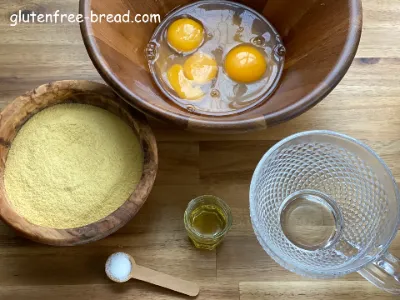
Step 1
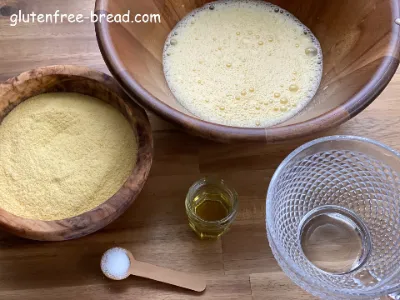
Step 2
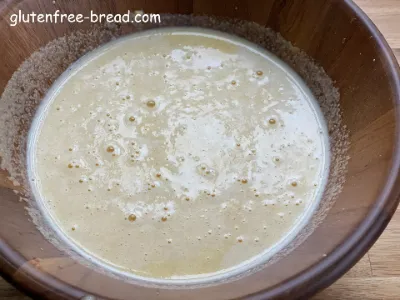
Step 3
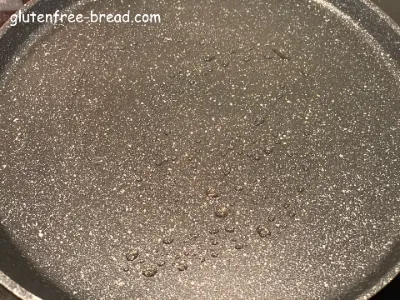
Step 4

Step 5
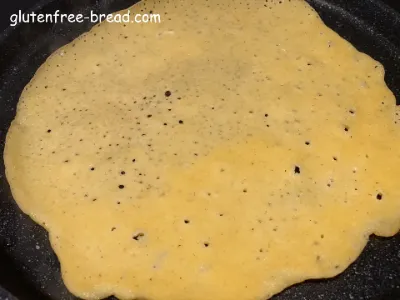
Step 6
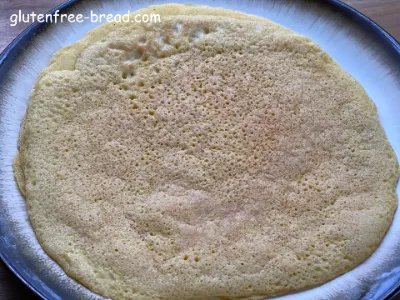
Step 7
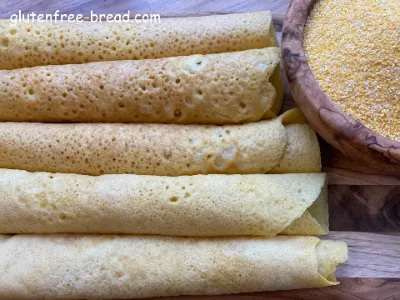
Step 8
Notes:
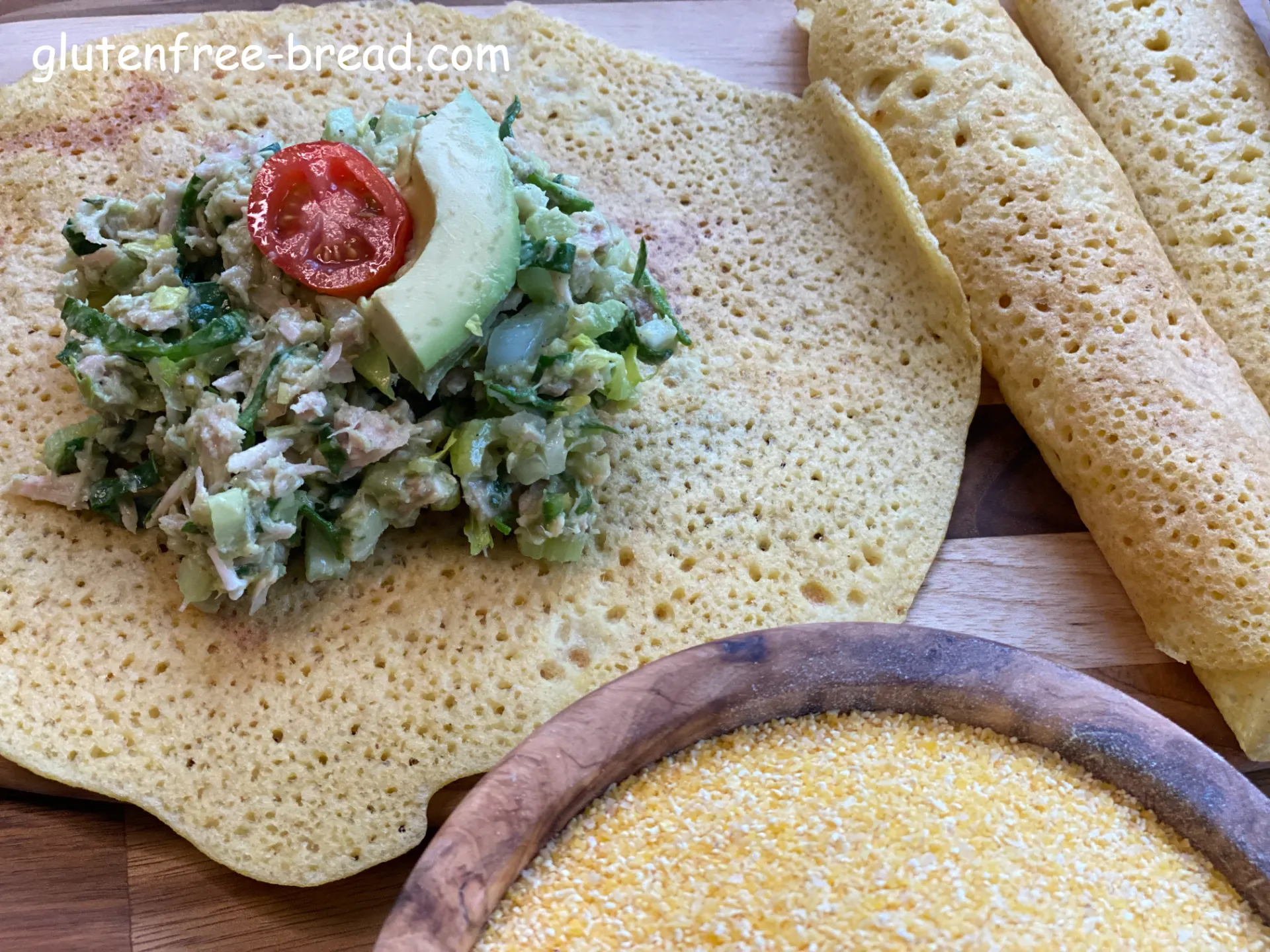
Corn Flour Crepes
Here are some tips for making perfect crepes:
Use the right batter consistency: The crepe batter should be thin, similar to the consistency of heavy cream. If it's too thick, the crepes will be too dense; if it's too thin, they may tear easily.
Let the batter rest: Allow the batter to rest for at least 10 minutes before cooking. This allows the flour/grains to fully hydrate and results in smoother crepes.
Preheat the pan: Preheat a non-stick skillet or crepe pan over medium heat before adding the batter. The pan should be hot enough that a drop of water sizzles and evaporates immediately.
Use the right amount of batter: Pour just enough batter into the pan to thinly coat the bottom when swirled. You can use a ladle or measuring cup to portion out the batter.
Swirl the batter: Once you pour the batter into the pan, quickly tilt and rotate the pan to spread the batter evenly in a thin layer. This helps create a uniform thickness for the crepe.
Cook on one side first: Cook the crepe on one side until the edges start to brown slightly and the surface appears dry, about 1-2 minutes.
Flip carefully: Use a thin spatula to gently lift and flip the crepe. If you're new to making crepes, you can use your fingers to help guide the crepe as you flip it.
Cook briefly on the other side: Cook the crepe on the other side for another 15 seconds or until lightly browned.
Addind baking soda:Adding baking soda to crepe batter is often optional. If a recipe calls for soda but you prefer not to use it or don't have any on hand, you can often omit it without affecting the outcome of the crepes. The crepes may be slightly denser and may not brown as evenly, but they still will be tasty and perfectly edible.
Keep warm: If you're making a large batch of crepes, you can keep them warm by covering the stack with a clean kitchen towel while you finish cooking the rest.
Experiment with fillings: Get creative with your crepe fillings! Sweet options like Nutella, fresh fruit, whipped cream, or jam are classic choices, while savory options like cheese, ham, spinach, or mushrooms can also be delicious.
With practice and patience, you'll be able to master the art of making perfect crepes every time!
Corn Flour Crepes additional information:
Corn flour, also known as maize flour or cornmeal, is derived from dried corn kernels through a process that involves milling or grinding. Here's an overview of its origin and processing:
Origin:
Corn (Maize) Cultivation: Corn is a cereal grain that originated in the Americas, particularly in Mesoamerica. It has been cultivated by indigenous peoples for thousands of years and played a crucial role in their diets and cultures.
Global Spread: Corn was introduced to Europe and other parts of the world after Christopher Columbus's voyages to the Americas in the late 15th century. It quickly spread across various continents due to its adaptability to different climates and its nutritional value.
Processing:
Harvesting and Drying:
- Corn is harvested when the kernels are mature and dried on the cob or mechanically dried in large-scale operations.
Milling:
- The dried corn kernels are then cleaned to remove impurities such as dirt and debris.
- The cleaned kernels are milled or ground to produce corn flour. The milling process can vary in fineness, producing fine, medium, or coarse corn flour depending on the desired end-use.
Types of Corn Flour:
- Cornmeal: Coarser than corn flour, cornmeal retains some of the hull and germ of the corn kernel, giving it a more textured consistency.
- Corn Flour: Finely ground, corn flour is often used for baking, thickening sauces, and making cornbread and tortillas.
Nutritional Considerations:
- Corn flour retains many of the nutritional components of corn, including carbohydrates, dietary fiber, vitamins (such as niacin and thiamine), minerals (such as iron and magnesium), and antioxidants (such as lutein and zeaxanthin).
- It is naturally gluten-free, making it suitable for individuals with gluten intolerance or celiac disease.
Industrial and Artisanal Uses:
- Corn flour is used widely in both industrial food production and traditional cooking practices. It is a staple ingredient in various cuisines around the world, contributing to dishes ranging from polenta in Italy to arepas in South America.
In summary, corn flour's journey from its origins in the Americas to its global use today highlights its importance in diverse culinary traditions and its nutritional value as a versatile grain product.
Corn flour offers several nutritional benefits:
Carbohydrates: Corn flour is primarily composed of carbohydrates, providing energy to the body. It is a complex carbohydrate, which means it provides sustained energy over time.
Protein: While corn flour contains protein, it is not as high in protein as some other flours. However, it still contributes to your daily protein intake.
Dietary Fiber: It contains dietary fiber, which supports digestive health and helps maintain regular bowel movements.
Vitamins: Corn flour is a source of several vitamins, including:
- Niacin (Vitamin B3): Important for energy metabolism and skin health.
- Thiamine (Vitamin B1): Essential for nerve function and carbohydrate metabolism.
- Folate (Vitamin B9): Important for DNA synthesis and cell growth.
Minerals: It contains minerals such as iron, magnesium, phosphorus, and potassium, which play vital roles in various bodily functions, including bone health, muscle function, and electrolyte balance.
Gluten-Free: Corn flour is naturally gluten-free, making it suitable for people with gluten intolerance or celiac disease.
Antioxidants: Corn flour contains antioxidants like carotenoids (including lutein and zeaxanthin), which help protect cells from damage caused by free radicals.
Low in Fat: Corn flour is relatively low in fat, making it a good choice for those watching their fat intake.
However, it's important to note that the nutritional content of corn flour can vary depending on factors such as the variety of corn used, processing methods, and any fortification added by manufacturers. Incorporating corn flour into a balanced diet that includes a variety of other whole grains, fruits, vegetables, and lean proteins can help ensure a well-rounded intake of nutrients.
Corn flour, or maize flour, is a versatile ingredient with a wide range of culinary uses across different cuisines worldwide:
Baking:
- Cornbread: Corn flour is a key ingredient in traditional cornbread recipes, imparting a sweet and slightly nutty flavor with a dense, crumbly texture.
- Muffins and Pancakes: It can be used to make muffins, pancakes, and waffles, adding a unique taste and texture to these breakfast favorites.
Breading and Coatings:
- Corn flour is often used as a gluten-free alternative for breading meats and vegetables before frying. It creates a crispy exterior when fried or baked, making it ideal for dishes like fried chicken or tempura.
Thickening Agent:
- Due to its ability to absorb liquid and form a smooth consistency, corn flour is used as a thickening agent in soups, stews, sauces, and gravies. It provides a silky texture without altering the flavor of the dish.
Corn Tortillas and Wraps:
- In Latin American cuisine, particularly in Mexico, corn flour (masa harina) is used to make corn tortillas, tamales, and other types of flatbreads. These are staple foods that accompany various dishes or serve as the base for tacos and enchiladas.
Polenta:
- In Italian cuisine, corn flour is cooked with water or broth to make polenta, a creamy and hearty dish that can be served soft or firm. It can be flavored with cheese, herbs, or vegetables and served as a side dish or a main course.
Desserts:
- Corn flour can be used in desserts such as puddings, cakes, and cookies, adding a subtle sweetness and a tender texture to baked goods.
Traditional Dishes:
- Various cultures have traditional dishes that feature corn flour prominently, such as arepas in Colombia and Venezuela, pupusas in El Salvador, and cornbread in the southern United States. These dishes showcase the versatility and importance of corn flour in regional cuisines.
Overall, corn flour's ability to provide texture, flavor, and a gluten-free option makes it a valuable ingredient in both traditional and modern cooking. Its presence spans across a diverse array of dishes, contributing to the rich culinary heritage of many cultures around the world.
Corn flour has a distinctive flavor profile that contributes to its popularity in various culinary traditions:
Sweetness: Corn flour has a mild natural sweetness, which adds a pleasant hint of sweetness to dishes without being overpowering. This sweetness is more pronounced in dishes where corn flour is a primary ingredient, such as cornbread or corn muffins.
Nutty and Earthy: It carries a subtle nutty and earthy undertone, which enhances the overall flavor profile of dishes. This characteristic makes it suitable for both savory and sweet preparations.
Subtle Corn Flavor: Corn flour retains the essence of corn, offering a delicate corn flavor that is distinctive but not overwhelming. This flavor becomes more pronounced when corn flour is toasted or cooked.
Versatility: The neutral yet slightly sweet and nutty flavor of corn flour allows it to complement a wide range of ingredients and flavors. It pairs well with savory ingredients like cheeses, herbs, and meats, as well as with sweet flavors like honey, fruits, and chocolate.
Enhanced by Cooking Methods: The flavor of corn flour can be enhanced through various cooking methods, such as frying for breading, baking for cakes and breads, or boiling for polenta. Each method can bring out different aspects of its flavor profile.
In summary, corn flour's flavor profile is characterized by its mild sweetness, nutty undertones, and subtle corn flavor, making it a versatile ingredient that adds depth and richness to a variety of dishes in cuisines around the world.
When considering the health aspects of corn flour (maize flour), here are some important factors to keep in mind:
Gluten-Free: Corn flour is naturally gluten-free, which makes it a safe alternative for individuals with celiac disease or gluten sensitivity.
Nutritional Content: Corn flour contains several nutrients, including:
- Carbohydrates: It is a good source of carbohydrates, providing energy to the body.
- Dietary Fiber: It contains dietary fiber, which promotes digestive health and helps regulate blood sugar levels.
- Protein: While it contains some protein, the amount is relatively modest compared to other sources.
- Vitamins and Minerals: Corn flour contains various vitamins and minerals, such as niacin (vitamin B3), thiamine (vitamin B1), folate (vitamin B9), magnesium, phosphorus, and potassium.
Caloric Density: Corn flour is calorie-dense, meaning it provides a significant amount of calories per serving. Portion control is important, especially for individuals watching their calorie intake.
Glycemic Index: Corn flour has a moderate glycemic index (GI), which means it can impact blood sugar levels. Combining it with foods that have a lower GI, such as proteins and vegetables, can help mitigate its effect on blood sugar.
Potential for Allergies: While corn itself is not a common allergen, some individuals may have allergies or sensitivities to corn or its derivatives. It's important to be aware of any adverse reactions and consult with a healthcare professional if needed.
Processing and Additives: Depending on the brand and processing methods, corn flour may contain additives or be enriched with vitamins and minerals. Choosing whole grain corn flour and avoiding highly processed versions can help maximize its nutritional benefits.
Incorporating corn flour into a balanced diet that includes a variety of whole grains, fruits, vegetables, and lean proteins can provide a range of essential nutrients and contribute to overall health. As with any food, moderation and variety are key to deriving the most benefit from corn flour while considering individual health needs and preferences.







